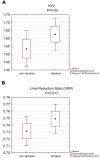The Effect of Mechanically-Generated Vibrations on the Efficacy of Hemodialysis; Assessment of Patients' Safety: Preliminary Reports
- PMID: 30781708
- PMCID: PMC6406417
- DOI: 10.3390/ijerph16040594
The Effect of Mechanically-Generated Vibrations on the Efficacy of Hemodialysis; Assessment of Patients' Safety: Preliminary Reports
Abstract
Muscle activity during a hemodialysis procedure improves its efficacy. We have formulated a hypothesis that vibrations generated by a specially-designed dialysis chair can, the same as physical exercise, affect the filtering of various fluids between fluid spaces during the hemodialysis procedure. This prospective and interventional study included 21 dialyzed patients. During a single dialysis session, each patient used a prototype device with the working name "vibrating chair". The chair's drive used a low-power cage induction motor, which, along with the worm gear motor, was a part of the low-frequency (3.14 Hz) vibration-generating assembly with an amplitude of 4 mm. Tests and measurements were performed before and after the vibration dialysis. After a single hemodialysis session including five 3-min cycles of vibrations, an increase in K t / V in relation to non-vibration K t / V ( 1.53 ± 0.26 vs. 1.62 ± 0.23 ) was seen. Urea reduction ratio increased significantly ( 0.73 ± 0.03 vs. 0.75 ± 0.03 ). A significant increase in systolic blood pressure was observed between the first and the third measurement ( 146 ± 18 vs. 156 ± 24 ). The use of a chair generating low-frequency vibrations increased dialysis adequacy; furthermore, it seems an acceptable and safe alternative to intradialytic exercise.
Keywords: Kt/V; hemodialysis; physical activity; urea reduction ratio (URR); vibrations.
Conflict of interest statement
The authors declare no conflict of interest. The funders had no role in the design of the study; in the collection, analyses, or interpretation of data; in the writing of the manuscript; nor in the decision to publish the results.
Figures



Similar articles
-
Assessing dialysis adequacy and dietary intake in the individual hemodialysis patient.Kidney Int. 1999 May;55(5):1961-9. doi: 10.1046/j.1523-1755.1999.00412.x. Kidney Int. 1999. PMID: 10231460 Clinical Trial.
-
Effect of predialysis eating on measurement of urea reduction ratio and Kt/V.Adv Chronic Kidney Dis. 2004 Oct;11(4):398-403. doi: 10.1053/j.arrt.2004.04.008. Adv Chronic Kidney Dis. 2004. PMID: 15492978
-
Is post-dialysis urea rebound significant with long slow hemodialysis?Blood Purif. 1998;16(4):187-96. doi: 10.1159/000014334. Blood Purif. 1998. PMID: 9736788 Clinical Trial.
-
Lessons from the Hemodialysis (HEMO) Study: an improved measure of the actual hemodialysis dose.Am J Kidney Dis. 1999 Jan;33(1):142-9. doi: 10.1016/s0272-6386(99)70272-6. Am J Kidney Dis. 1999. PMID: 9915282 Review.
-
National Kidney Foundation report on dialyzer reuse. Task Force on Reuse of Dialyzers, Council on Dialysis, National Kidney Foundation.Am J Kidney Dis. 1997 Dec;30(6):859-71. doi: 10.1016/s0272-6386(97)90096-2. Am J Kidney Dis. 1997. PMID: 9398135 Review.
References
-
- Yamamoto S., Kazama J.J., Wakamatsu T., Takahashi Y., Kaneko Y., Goto S., Narita I. Removal of uremic toxins by renal replacement therapies: A review of current progress and future perspectives. Ren. Replace. Ther. 2016;2:43. doi: 10.1186/s41100-016-0056-9. - DOI
-
- Minutolo R., Bellizzi V., Cioffi M., Iodice C., Giannattasio P., Andreucci M., Terracciano V., Di Iorio B.R., Conte G., De Nicola L. Postdialytic Rebound of Serum Phosphorus: Pathogenetic and Clinical Insights. J. Am. Soc. Nephrol. 2002;13:1046–1054. - PubMed
Publication types
MeSH terms
LinkOut - more resources
Full Text Sources
Medical

